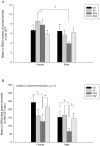Fluoxetine during development reverses the effects of prenatal stress on depressive-like behavior and hippocampal neurogenesis in adolescence
- PMID: 21912658
- PMCID: PMC3164681
- DOI: 10.1371/journal.pone.0024003
Fluoxetine during development reverses the effects of prenatal stress on depressive-like behavior and hippocampal neurogenesis in adolescence
Abstract
Depression during pregnancy and the postpartum period is a growing health problem, which affects up to 20% of women. Currently, selective serotonin reuptake inhibitor (SSRIs) medications are commonly used for treatment of maternal depression. Unfortunately, there is very little research on the long-term effect of maternal depression and perinatal SSRI exposure on offspring development. Therefore, the aim of this study was to determine the role of exposure to fluoxetine during development on affective-like behaviors and hippocampal neurogenesis in adolescent offspring in a rodent model of maternal depression. To do this, gestationally stressed and non-stressed Sprague-Dawley rat dams were treated with either fluoxetine (5 mg/kg/day) or vehicle beginning on postnatal day 1 (P1). Adolescent male and female offspring were divided into 4 groups: 1) prenatal stress+fluoxetine exposure, 2) prenatal stress+vehicle, 3) fluoxetine exposure alone, and 4) vehicle alone. Adolescent offspring were assessed for anxiety-like behavior using the Open Field Test and depressive-like behavior using the Forced Swim Test. Brains were analyzed for endogenous markers of hippocampal neurogenesis via immunohistochemistry. Results demonstrate that maternal fluoxetine exposure reverses the reduction in immobility evident in prenatally stressed adolescent offspring. In addition, maternal fluoxetine exposure reverses the decrease in hippocampal cell proliferation and neurogenesis in maternally stressed adolescent offspring. This research provides important evidence on the long-term effect of fluoxetine exposure during development in a model of maternal adversity.
Conflict of interest statement
Figures




Similar articles
-
Developmental exposure to SSRIs, in addition to maternal stress, has long-term sex-dependent effects on hippocampal plasticity.Psychopharmacology (Berl). 2015 Apr;232(7):1231-44. doi: 10.1007/s00213-014-3758-0. Epub 2014 Oct 12. Psychopharmacology (Berl). 2015. PMID: 25304865
-
Prenatal stress and early-life exposure to fluoxetine have enduring effects on anxiety and hippocampal BDNF gene expression in adult male offspring.Dev Psychobiol. 2016 May;58(4):427-38. doi: 10.1002/dev.21385. Epub 2015 Nov 26. Dev Psychobiol. 2016. PMID: 26608001
-
Perinatal fluoxetine increases hippocampal neurogenesis and reverses the lasting effects of pre-gestational stress on serum corticosterone, but not on maternal behavior, in the rat dam.Behav Brain Res. 2018 Feb 26;339:222-231. doi: 10.1016/j.bbr.2017.11.038. Epub 2017 Dec 5. Behav Brain Res. 2018. PMID: 29203333
-
Perinatal SSRI medications and offspring hippocampal plasticity: interaction with maternal stress and sex.Hormones (Athens). 2018 Mar;17(1):15-24. doi: 10.1007/s42000-018-0011-y. Hormones (Athens). 2018. PMID: 29858853 Review.
-
The age-dependent effects of selective serotonin reuptake inhibitors in humans and rodents: A review.Prog Neuropsychopharmacol Biol Psychiatry. 2011 Aug 1;35(6):1400-8. doi: 10.1016/j.pnpbp.2010.09.013. Epub 2010 Sep 25. Prog Neuropsychopharmacol Biol Psychiatry. 2011. PMID: 20883714 Review.
Cited by
-
Serotonin-related rodent models of early-life exposure relevant for neurodevelopmental vulnerability to psychiatric disorders.Transl Psychiatry. 2021 May 11;11(1):280. doi: 10.1038/s41398-021-01388-6. Transl Psychiatry. 2021. PMID: 33976122 Free PMC article. Review.
-
Antidepressant-like effects of acupuncture involved the ERK signaling pathway in rats.BMC Complement Altern Med. 2016 Sep 29;16(1):380. doi: 10.1186/s12906-016-1356-x. BMC Complement Altern Med. 2016. PMID: 27680977 Free PMC article.
-
Subjecting Dams to Early Life Stress and Perinatal Fluoxetine Treatment Differentially Alters Social Behavior in Young and Adult Rat Offspring.Front Neurosci. 2019 Mar 12;13:229. doi: 10.3389/fnins.2019.00229. eCollection 2019. Front Neurosci. 2019. PMID: 30914920 Free PMC article.
-
Developmental exposure to SSRIs, in addition to maternal stress, has long-term sex-dependent effects on hippocampal plasticity.Psychopharmacology (Berl). 2015 Apr;232(7):1231-44. doi: 10.1007/s00213-014-3758-0. Epub 2014 Oct 12. Psychopharmacology (Berl). 2015. PMID: 25304865
-
Sex-dependent effects of maternal corticosterone and SSRI treatment on hippocampal neurogenesis across development.Biol Sex Differ. 2017 Jun 2;8:20. doi: 10.1186/s13293-017-0142-x. eCollection 2017. Biol Sex Differ. 2017. PMID: 28580124 Free PMC article.
References
-
- Almond P. Postnatal depression: a global public health perspective. Perspect Public Health. 2009;129:221–227. - PubMed
-
- Leung BM, Kaplan BJ. Perinatal depression: prevalence, risks, and the nutrition link–a review of the literature. J Am Diet Assoc. 2009;109:1566–1575. - PubMed
-
- Limlomwongse N, Liabsuetrakul T. Cohort study of depressive moods in Thai women during late pregnancy and 6–8 weeks of postpartum using the Edinburgh Postnatal Depression Scale (EPDS). Arch Womens Ment Health. 2006;9:131–138. - PubMed
-
- Marcus SM. Depression during pregnancy: rates, risks and consequences–Motherisk Update 2008. Can J Clin Pharmacol. 2009;16:e15–22. - PubMed
Publication types
MeSH terms
Substances
LinkOut - more resources
Full Text Sources
Medical

